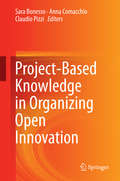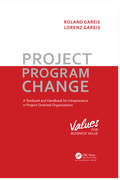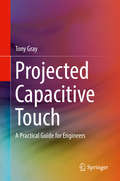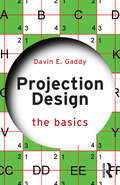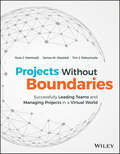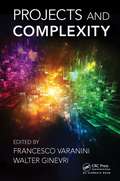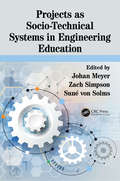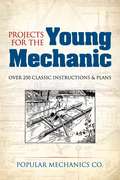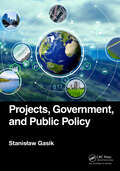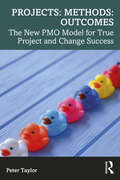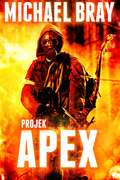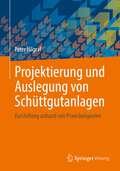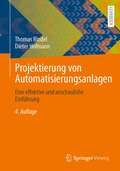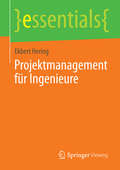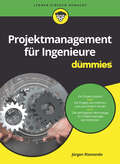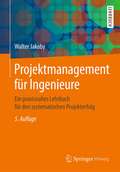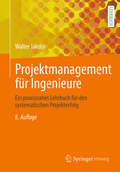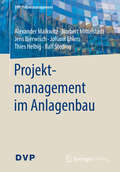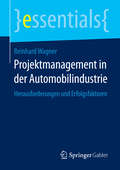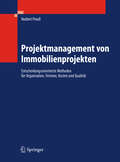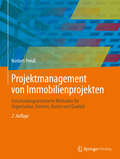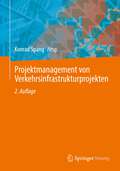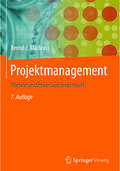- Table View
- List View
Project-Based Knowledge in Organizing Open Innovation
by Sara Bonesso Anna Comacchio Claudio PizziEnriching understanding of the current theoretical debate on project-based learning and R&D sourcing, 'Project-based Knowledge in Organizing Open Innovation' draws on innovation literature and knowledge-based perspectives to solve open problems in the relationship between knowledge development at project level and how firms organize product innovation combining in-house R&D activities with inbound open innovation. Through field research in different industrial settings (pharmaceutical, automotive and machine tools) and with complementary methodological approaches, this book provides empirical evidence on how project knowledge features affect sourcing decisions at firm level. Due to the emerging interest in the management literature on project-based organizations and on the relevance of project forms of organizing in a knowledge-based economy, this volume will appeal to scholars and students in business and management, in particular those in innovation management, organization theory and strategic management. Addressing the still open issue of how the firm level should be complemented by studies at the project level of analysis, this book provides theoretical and empirical arguments on the advantages of a more fine-grained level of analysis to understand how firms organize their innovation processes across boundaries.
Project. Program. Change
by Roland Gareis Lorenz GareisThis book gives managers an integrative approach to project, program, and change management. It describes the differences between change in projects versus programs with case studies in both areas and the different life cycles. While the project and change comprise much of the book, it is up to date with its emphasis on agile, scrum, and benefits. The book also describes methods to both initiate and manage a change and what must be done for success and business value.
Projected Capacitive Touch: A Practical Guide for Engineers
by Tony GrayThis book covers ALL aspects of projected capacitive touch sensors including basic principles, the physics of PCAP, capacitance measurements, touch sensor materials and construction, electrical noise, software drivers, and testing. It is targeted at working engineers who are implementing touch into their products as well as anyone else with an interest in how touch screens work.· Offers readers the first book on the use of projected capacitive (PCAP) touch technology for touch screens; · Explains not only how PCAP touch works, but also addresses the implementation details an engineer needs when incorporating PCAP into their product; · Includes explanations of different cover lens materials, cover lens coatings, software drivers, touch testing, and many other areas of general knowledge that would be useful to a design engineer.
Projection Design: The Basics (The Basics)
by Davin E. GaddyProjection Design: The Basics explores the concepts of visual elements in live entertainment. It provides a conversational view of the fundamentals of projection design, from production meetings and the elements of visual design to the equipment necessary to make it all happen.This text examines the themes and theories universal to a wide range of topics, to provide a foundation for anyone interested in using video for their live production or those who are looking where to start as a designer. Topics covered include: Methods of extracting visuals from a script and communicating them to production staff Basics of visual design Understanding human perception and how this influences design How to choose the right equipment to build a system With a detailed glossary, basic formulas, and comprehensive explanation from start to finish, Projection Design: The Basics is an ideal primer for Projection Design courses, and will be of interest to anyone entering the field of projection and media design for the first time.
Projects Without Boundaries: Successfully Leading Teams and Managing Projects in a Virtual World
by James M. Waddell Russ J. Martinelli Tim J. RahschulteClear, proven solutions for virtual project management challenges Projects Without Boundaries offers project managers a clear framework for bringing both project management practices and project team leadership principles to the virtual space. Written by a team of authors with years of experience managing nationally and internationally distributed teams, this book provides a suite of best practices, checklists, and actionable strategies for managing a project and building a high-performing team in a virtual and multicultural environment. Real-world examples illustrate the application of the concepts discussed, and the Virtual Project Readiness Assessment facilitates both team evaluation and transformation planning for virtual project management improvement. Each chapter focuses on the critical challenges encountered while managing virtual projects and details proven solutions that improve a virtual organization, boost project performance, and facilitate positive outcomes. Globalization and technological advances have merged to create dynamic, productive teams that work together from around the globe; this opportunity can bring great difficulty for project managers, who must negotiate hurdles that no not exist on traditional projects. This book provides ready-made solutions specific to distributed and multicultural teams, to help you achieve the full potential of the global talent pool. Overcome common challenges of virtual projects with distributed teams Navigate complex team dynamics to ensure effective collaboration Work seamlessly across borders, time zones, and cultures Determine optimal virtual communication and collaboration tools Apply traditional project management practices in a virtual setting A team fails or thrives on the strength of its management. Fitting the group's needs, expectations, personalities, and skills into a cohesive whole is seldom simple — and distance adds an additional layer of complexity. Projects Without Boundaries provides expert guidance on keeping it together, with proven practices, tools, and virtual team leadership strategies.
Projects and Complexity: Theory, Methods, And Applications (Systems Innovation Book Ser.)
by Adedeji B. BadiruHelpful to those tasked with managing complex environments, Projects and Complexity introduces a new way of looking at projects and fostering the culture needed to achieve sustainable results. It brings together experts from the academic, military, and business worlds to explore project management in the context of complexity theory and organizatio
Projects as Socio-Technical Systems in Engineering Education
by Johan Meyer Zach Simpson Suné Von SolmsThis book presents the case for Project-Based Learning within Socio-Technical Systems in Engineering Education. The book highlights the importance of projects as Socio-Technical Systems as a means for supporting and enhancing international accreditation of engineering programs. Practical examples illustrate how Socio-Technical Systems are brought into the educational environment through Project-Based Learning. The book goes on to discusses the impact this may have on Engineering Education practice. <P><P>The work presented will enable engineering educators to develop curricula that can respond to societal needs, while also enhancing teaching and learning. It offers an approach to engineering education that centers on engaging scholars in projects that are located within socio-technical systems. University, government and industry leaders will gain from this book as it provides insight into strategic planning and partnership-building for Engineering Education. We hope this book will further foster deep scholarship of research to ready engineering faculties for engaging responsibly with their surrounding communities. <P><P>Features: <li>Offers applications of Project-Based Learning (PBL) in Engineering Education <li>Matches elements of Socio-Technical Systems in Higher Engineering Education, with the Exit Level Outcomes (ELOs) required by professional engineering bodies <li>Provides practical examples for the establishment of project environments within an academic faculty <li>Shows examples in the success of execution of projects involving engineering educators, researchers, program developers, government agencies and industry partners <li>Presents a framework to develop Project-Based Learning in Engineering Education that addresses Socio-Technical requirements and will enable engineering educators to collaboratively develop engineering curricula with industry that will respond to societal needs
Projects for the Young Mechanic: Over 250 Classic Instructions & Plans (Dover Children's Activity Books)
by Popular Mechanics Co.From creating artificial pearls to building a steam boiler, these vintage projects for indoors and outdoors offer a tremendous range of possibilities. Over 250 classic plans and instructions explain how to make model airplanes, greeting cards, a motion-picture camera, a radiophone, a cipher code, motor-driven sleds, and other projects. Drawn from the best of Popular Mechanics magazines from the 1910s and '20s, they combine the excitement and satisfaction of building and creating with the lasting value of learning the practical applications of scientific principles.The step-by-step instructions are accompanied by charming drawings and photos that clearly illustrate each project. Girls and boys will be captivated by these antique instructions and plans, and adults will appreciate the projects' nostalgic appeal.
Projects, Government, and Public Policy
by Stanisław GasikMany governments have effectively organized public project implementation systems in their jurisdictions. At the same time, many other countries remain at a less advanced level of public project management. Globally, there is a need for project management knowledge to be transferred between governments. However, no systematic review of these practices has been developed to date. Projects, Government, and Public Policy was written to fulfill this need and presents a review of project management practices in countries with developed project-based capabilities. This book uses its own rigorous model to present this review systematically. This book’s practical purpose is to give a structured overview of government-level project management practices. This knowledge can be used in the work of governments to improve the management of public projects and the implementation of public policies. Many professionals working in public institutions understand project management concepts differently than project management professionals. Therefore, this book begins with a chapter that describes the differences between the conceptual basis of public administration and project management. The body of this book has five parts. Part I is mainly intended for those involved in government and public administration who want to acquire or increase knowledge about project management. Part II provides an overview of the basic concepts from the theory of public administration, public policies, and development management. Part III describes what makes public projects unique and the success factors specific to projects of this sector. Knowledge about effective government project management practices is covered in Part IV. The concluding Part V begins with a general overview of the maturity model concept. Its main part covers the description of a maturity model showing ways to systematically improve the implementation of public projects. This book is written for governments and government administrators, including the most influential decision-makers, who craft policies to guide a country’s development as well as how to implement projects. This book is also intended for supporters and enthusiasts of project management in government and public administration by providing them with a description of the solutions used by project management in public administration. This book is intended, too, for all project management practitioners working for public projects: project managers, team members, sponsors, and middle-level executives of project-delivering private companies. By knowing public administration concepts, they can manage their projects better and use a common language with their clients.
Projects: The New PMO Model for True Project and Change Success
by Peter TaylorMatching the speed of change in modern business, this book takes readers on a two-year journey in building a project management office (PMO) for today and tomorrow and redefines the PMO as to what it should focus on: Projects, Methods, and Outcomes. Many organisations invest heavily in PMOs, but these are built on an outdated and static model that does not fit a hybrid, agile, AI-empowered, and rapidly changing business environment. Building on his renowned "balanced PMO" model, project management leader Peter Taylor tackles today’s challenges with this diary-style guide to inspire all PMO leaders, project managers, and business leaders, and provide a roadmap to follow to build (or rebuild) their own PMOs. He presents a completely new definition of "PMO", eliminating the traditional back-office concept of a centralised PMO, with his "Projects: Methods: Outcomes" construct that provides a truly business focused team to oversee the delivery of value to their organisation. Enriched with case studies and practical models, this book will benefit all PMO leaders, project management professionals, change and transformation leaders, and anyone interested in how to deliver business value through projects.
Projek Apex
by Elaine Michael BrayWat as die mens se eerste kennis die resultate van sy eie verwoesting beteken? Van die beste verkoper van die Whisper Trilogy kom die nuwe boek. Richard Draven is 'n wetenskaplike wat geintreseerd is in die helende einskappe van spesies en die oordrag aan die mensdom. toe hy 'n nuwe aapspesie ontdek met regenerasie vermoeë, het hy geen idee wat se kettingreaksie sy verslag tot gevolg sou hê nie. ses jaar later, is Draven se navorsing in die praktyk gebruik.Die regering het 'n virus gemaak wat op die mens gebruik is. Sy funksie- om die weermag sterker, vinniger en beter te maak om die konflik globaal te verbeter. iets was egter nie pluis nie. verskeie verslae en getoon dat die virus 'n snaakse uitwerking op die mense het wat daaraan bloodgestel is, en het die mense in beheer baie senuweeagtig gemaak. Soos die Apex groep kontak verbreek en nie meer bevele gehoorsaam nie, en die regering onraad vermoed. Joshua Cook was die alpha, die eerste wat aan die virus bloodgestel is en suksesvol gebind het. Joshua was moeg vir die mensdom, moeg vir hulle vernietigende natuur. Hy het 'n plan, een om die bord skoon te maak en die minder gegoede inwoners van die aarde te vee, en dan te vervang met sy eie volk. Soos die diepte van Joshua aan die regering duidelik raak is hulle genoodsaak om hulle tot Richard Draven te wend om 'n mannier te kry om Joshua se groeiende weermag te stuit voor hy die mensdom van die aarde kan uitwis. In die tradisie van skrywers soos Micheal Crichon, Joe Hart en James Patterson, is Projek Apex 'n spanningsvolle, globale riller, wat plaas vind oor verskeie lande met gevlegte tydlynne, van die regeringstaat Washington, tot die gopse van Mumbai en die brandende hitte van die Irakkiese woestyn, Projek Apex bied kleurvolle kerakters, met hulle eie motivering en hoofreded wat 'n storie vertel van menslike konflik wat tydens 'n globale gebeurtenis terugval na die primitiewe wat onderdruk was deur gemeenskap sos die wêreld om hulle verkrummel
Projekt- und Teamarbeit in der digitalisierten Arbeitswelt: Herausforderungen, Strategien und Empfehlungen
by Erich Latniak Simone Kauffeld Susanne Mütze-Niewöhner Winfried Hacker Thomas Hardwig Manuel Nicklich Ulrike PietrzykEin interdisziplinäres Open-Access-Buch für Wissenschaft und Praxis. Projekt- und Teamarbeit besitzen als Formen der Arbeitsorganisation eine hohe praktische Relevanz, die mit den Möglichkeiten der Digitalisierung und Vernetzung noch zunimmt. Der Fokus der öffentlichen Debatte um die Digitalisierung der Arbeit liegt auf technologischen und datentechnischen Innovationen. Dieses Sammelwerk ergänzt die Diskussion, indem es sowohl die Potenziale kooperativer Arbeitsformen für die Bewältigung aktueller Herausforderungen als auch die Auswirkungen digitaler Transformationsprozesse auf die Projekt- und Teamarbeit beleuchtet. Es diskutiert notwendige soziale Innovationen und liefert wichtige Impulse für die Humanisierung von Arbeit. Die Beiträge behandeln insgesamt ein breites Spektrum aktueller Fragen rund um die Gestaltung und Führung von digital unterstützter Arbeit in agilen, virtuellen oder hybriden Teams und Projekten. Jeder Beitrag schließt mit konkreten Empfehlungen für die Praxis.
Projektierung und Auslegung von Schüttgutanlagen: Darstellung anhand von Praxisbeispielen
by Peter HilgrafDieses Fachbuch befasst sich mit der verfahrenstechnischen Projektierung und Auslegung von Schüttgut handhabenden Anlagen.
Projektierung von Automatisierungsanlagen: Eine effektive und anschauliche Einführung
by Dieter Hofmann Thomas BindelIn diesem Lehrbuch werden die wesentlichen Schritte und Abläufe für die Planung und Durchführung von Automatisierungsprojekten im Bereich der Verfahrenstechnik beschrieben, wobei sowohl kontinuierliche als auch ereignisdiskrete Prozesse betrachtet werden. Ausgehend vom allgemeinen Aufbau einer Automatisierungsanlage werden dazu Erarbeitung und Inhalt der wesentlichen Projektunterlagen, Steuerungs- bzw. Regelungsentwurf sowie Grundlagen zur Projektierung der Hilfsenergieversorgung erläutert, wobei hinsichtlich des R&I-Fließschemas auch auf den Übergang von DIN 19227 zu DIN EN 62424 sowie hinsichtlich des EMSR-Stellenplans von DIN 40719 zu DIN EN 81346 eingegangen wird. Darstellungen zur Angebotserstellung und Kalkulation von Automatisierungsprojekten runden das Thema ab.
Projektmanagement für Ingenieure (essentials)
by Ekbert HeringAufgaben werden in einer globalen, wettbewerbsorientierten Umwelt immer komplexer und müssen schnell und zuverlässig bewältigt werden. Um die geforderten Leistungen qualitätsgerecht und innerhalb des erforderlichen Kosten- und Zeitrahmens zu erbringen, muss ein professionelles Projektmanagement angewandt werden. Nach der Definition der wichtigen Begriffe ,,Projekt" und ,,Projektmanagement" werden die Projektphasen aufgezeigt. Für die einzelnen Projekte stehen unterschiedliche Formen der Projektorganisation zur Verfügung. Es werden die verschiedenen Methoden zur Projektplanung und -steuerung vorgestellt. Behandelt werden die wichtigen Werkzeuge zur Kosten- und Terminplanung sowie zur Risikoabschätzung. Ausführlich wird an Hand eines Beispiels der Einsatz der Netzplantechnik vorgestellt sowie die Methoden zur Kontrolle von Zeit und Kosten erläutert. Die Zusammenstellung der nationalen und internationalen Normen sowie der nationalen und internationalen Institutionen des Projektmanagements runden das Buch ab.
Projektmanagement für Ingenieure für Dummies (Für Dummies)
by Jurgen RismondoSie sollen ein Projekt betreuen, kennen sich technisch gut aus, sind sich aber nicht sicher, wie Sie es organisieren und verwalten, also managen sollen? Genau dafür hat Jürgen Rismondo dieses Buch geschrieben. Er erklärt, was Projektmanagement ist, wie Sie Projekte Schritt für Schritt planen, was die Konzept- und was die Designphase ist. Das Buch hilft Ihnen auch bei der Projektausführung und der Überwachung und Steuerung von Projektarbeit. Einen gesonderten Blick wirft der Autor dabei auf den Menschen als Projektmitarbeiter und geht zuletzt noch auf Werkzeuge und alternative Ansätze des Projektmanagements ein.
Projektmanagement für Ingenieure: Ein praxisnahes Lehrbuch für den systematischen Projekterfolg
by Walter JakobyDas Lehrbuch bietet eine praxisnahe Einführung in die Planung und Steuerung von Projekten. Die benötigten Prozesse, Methoden und Tools werden anschaulich als Bausteine eines durchgängigen, an bewährten Standards orientierten Konzepts dargestellt, bei dem Probleme zielgerichtet gelöst, Arbeitsprozesse strukturiert geplant und Projektteams termintreu geführt werden.Die Anwendung wird an vielen Beispielen aus den Bereichen Automation, Software, Elektronik, IT, Mechatronik und Bauwesen demonstriert; Fallbeispiele aus realen Projekten veranschaulichen den praktischen Nutzen; Formulare und Checklisten unterstützen die direkte Umsetzung; Verständnisfragen und Übungsaufgaben am Ende jedes Kapitels vertiefen und festigen das Wissen auf einem Niveau, das für die Leitung von Projekten erwartet wird.
Projektmanagement für Ingenieure: Ein praxisnahes Lehrbuch für den systematischen Projekterfolg
by Walter JakobyDas Lehrbuch bietet eine praxisnahe Einführung in die Planung und Steuerung von Projekten. Die benötigten Prozesse, Methoden und Tools werden anschaulich als Bausteine eines durchgängigen, an bewährten Standards orientierten Konzepts dargestellt, bei dem Probleme zielgerichtet gelöst, Arbeitsprozesse strukturiert geplant und Projektteams termintreu geführt werden.Die Anwendung der PM-Methoden wird anschaulich erklärt und an vielen Beispielen demonstriert. Fallbeispiele realer Projekte aus den Bereichen Automation, Software, Elektronik, IT, Mechatronik und Bauwesen vertiefen und festigen das Wissen auf einem Niveau, das für die Leitung von Projekten erwartet wird.
Projektmanagement für Ingenieure: Ein praxisnahes Lehrbuch für den systematischen Projekterfolg
by Walter JakobyDas Lehrbuch bietet eine praxisnahe Einführung in die Planung und Steuerung von Projekten. Die im kompletten Projekt-Lebenszyklus benötigten Methoden, Tools und Prozesse werden anschaulich als Bausteine eines durchgängigen, Konzepts dargestellt, bei dem Probleme zielgerichtet gelöst, Arbeitsprozesse strukturiert geplant und Projektteams termintreu geführt werden.Die Anwendung sowohl klassischer, als auch agiler PM-Methoden wird anschaulich erklärt und an vielen Beispielen demonstriert. Ein eigenes Kapitel ist dem Einsatz digitaler PM-Werkzeuge gewidmet mit einem Ausblick auf den Einsatz KI-basierter Algorithmen.Fallbeispiele realer Projekte aus den Bereichen Automation, Software, Elektronik, IT, Mechatronik und Bauwesen vertiefen und festigen das Wissen auf einem Niveau, das für die Leitung von Projekten erwartet wird.
Projektmanagement im Anlagenbau (Dvp Projektmanagement Ser.)
by Alexander Malkwitz Norbert Mittelstädt Jens Bierwisch Johann Ehlers Thies Helbig Ralf StedingMit diesem Fachbuch ,,Projektmanagement im Anlagenbau" werden alle Projektphasen eines typischen Projekts im Anlagenbau erfasst. Die Autoren beschreiben die einzelnen Leistungen der Projektsteuerung. Als Leistungsbild und Standard f#65533;r das Projektmanagement im Bauwesen haben sich die Vorschl#65533;ge der AHO-Schriftenreihe Nr. 9 etabliert. Der Anlagenbau erfordert bei vielen #65533;bereinstimmungen in systematischer und methodischer Hinsicht spezifische Herangehensweisen. Dementsprechend hat der DVP-Arbeitskreis Anlagenbau die Aufgabe #65533;bernommen, f#65533;r diesen Gesch#65533;ftsbereich ein den branchenspezifischen Anforderungen Rechnung tragendes Leistungsmodell zu erarbeiten. Diese Leistungen gelten f#65533;r die ganze Vielfalt der Anlagenbauprojekte. Das Fachbuch kommt dem erforderlichen Standardisierungsbedarf bei der Beauftragung von Leistungen entgegen. Das gesamte Leistungsbild des Projektmanagements wird in f#65533;nf Handlungsbereiche differenziert und diese Handlungsbereiche wieder in Grundleistungen und besondere Leistungen unterteilt. Die spezifischen Leistungen des Projektmanagements werden getrennt nach diesen Handlungsbereichen in verschiedenen Projektstufen von der Vorbereitung #65533;ber das Basic-Engineering, die Vergabe, das Detailed-Engineering, die Ausf#65533;hrung und den Projektabschluss dargestellt. Diese Matrix erm#65533;glicht es den Nutzern des Fachbuches in Erg#65533;nzung des AHO-Heftes Nr. 9 nach ihrer Wahl das gesamte Leistungsbild, aber auch Teilleistungen punktgenau zu beschreiben und zu vergeben. In dieser Gliederung der Handlungsbereiche und der Projektphasen wird jede einzelne Teilleistung von den Autoren kommentiert, um dem Leser das Bild jeder Leistung des Projektmanagements im Anlagenbau zu verdeutlichen.
Projektmanagement in der Automobilindustrie: Herausforderungen und Erfolgsfaktoren (essentials)
by Reinhard WagnerReinhard Wagner stellt die Anforderungen an das Projektmanagement in der Automobilindustrie sowie wichtige Trends, Erfolgsfaktoren und Herausforderungen vor. Die Automobilindustrie ist eine der weltweit bedeutendsten Branchen. Seit mehr als 100 Jahren werden Automobile entwickelt und in Massenfertigung hergestellt. Die Konjunkturschwankungen der letzten Jahrzehnte haben Automobilhersteller und Zulieferer dazu veranlasst, sich auf ihre Kernkompetenzen zu fokussieren. Da Autos aber ein Kombinationsprodukt sind, ist eine Zusammenarbeit über Unternehmens- und zunehmend auch Landesgrenzen hinweg notwendig. Hier setzt erfolgreiches Projektmanagement an: Es integriert alle Beteiligten und hilft, anspruchsvolle Ziele für die Entwicklung und Fertigung von Fahrzeugen möglichst effizient zu erreichen.
Projektmanagement von Immobilienprojekten
by Norbert PreußMotiv des vorliegenden Buches ist die Notwendigkeit, dass Entscheidungen in Projekten rechtzeitig vorbereitet, getroffen und umgesetzt werden müssen. Zielsetzung ist es, diese Entscheidungsprozesse aus der Sichtweise des Projektmanagers zu untersuchen, der in den Handlungsbereichen Organisation, Qualitäten und Quantitäten, Kosten und Finanzierung sowie Termine und Kapazitäten seine Aufgabe findet. Nach Definition der Projektziele sind Alternativen zur Erreichung der Projektziele zu entwickeln und zu entscheiden. Ausgehend vom Leistungsbild der Projektsteuerung wird ein Kompendium der maßgeblichen Entscheidungsbedürfnisse und -prozesse und im Projektmanagement von Hochbauten dargestellt.
Projektmanagement von Immobilienprojekten: Entscheidungsorientierte Methoden für Organisation, Termine, Kosten und Qualität
by Norbert PreußDieses Buch erläutert ausführlich die Rolle des Projektmanagers mit seinem Leistungsbild als Ausgangspunkt und stellt dann dessen Aufgaben mit Beispielen für viele Anwendungssituationen dar. Alle Phasen der Projektabwicklung werden mit detaillierten Terminplänen erläutert und Abhängigkeiten aufgezeigt. Strukturabläufe zur Steuerung von Nachhaltigkeitskriterien, Änderungsmanagement, Nutzungskostenmanagement, Nutzermanagement, Projektcontrolling, Konfliktmanagement und Projektmanagement bei Bestandsbauten runden das Werk ab. Ein wesentlicher Aspekt der Darstellung ist die Entscheidungsorientierung, die alle Kapitel prägt. Zur Ordnung und Auswertung der Entscheidungsprozesse wird eine Struktur entworfen, die im Hinblick auf verschiedene Parameter analysiert und auf praktische Anwendungssituationen beispielhaft übertragen wird.
Projektmanagement von Verkehrsinfrastrukturprojekten
by Konrad SpangDieses von Fachexperten geschriebene Werk umfasst alle wesentlichen Schritte und Elemente des Projektmanagements von Straßen- und Eisenbahnprojekten und füllt damit eine seit langem offene Literaturlücke für die Praxis. Behandelt werden alle Prozesse der Planung, der Erarbeitung des Baurechts mit der Einbeziehung des Umfelds, der Organisation der Finanzierung, der Bauvorbereitung und der Baudurchführung aus Sicht der Bauherren und ihrer Planer. Wesentliche Elemente sind u.a. Projektcontrolling, Risikomanagement, Termin- und Kostenplanung, Stakeholdermanagement, Planrechtsverfahren, Ausschreibung und Vergabe. Verkehrsinfrastruktur hat eine zentrale Bedeutung für das Funktionieren einer Gesellschaft und für die Entwicklung der Wirtschaft. Kenntnisse über Planung und Realisierung von Verkehrswegen (Straßen und Schienenwege) werden im Hinblick auf die technischen und baubetrieblichen Aspekte an den Universitäten und Fachhochschulen vermittelt. Die berufstätigen Ingenieure haben dort ihr Fachwissen erworben. Mit diesem Werk liegt nun für die Praktiker ein Handbuch und ein Leitfaden für alle wesentlichen Prozesse in der Projektabwicklung (also von der Idee bis zur Inbetriebnahme) vor.
Projektmanagement: Theorie und Praxis aus einer Hand
by Bernd-J MadaussIn der siebten Neuauflage dieses Fachbuchs werden alle wesentlichen Aspekte des Projektmanagements in Theorie und Praxis umfassend behandelt. F#65533;r Beh#65533;rden und Unternehmen die mit der Abwicklung nationaler und internationaler Projektaufgaben befasst sind, ist der Einsatz eines professionellen Projektmanagements eine zwingende Voraussetzung um den globalen Wettbewerb erfolgreich zu bestehen. In diesem Buch werden die Teilprozesse des Projektmanagements beschrieben und durch Praxisbeispiele erg#65533;nzt. Kernthemen sind: die Bedeutung des Projektmanagements f#65533;r Industrie und Beh#65533;rden, Projektpannen und ihre Behebung, Zieldefinition und Lebenszyklus, Organisationskonzepte, Systemf#65533;hrung und Qualit#65533;tsmanagement im Projekt, Strukturierungsmethoden, Planung und #65533;berwachung, Kostenermittlung, Konfigurations#65533;berwachung, #65533;nderungsmanagement, Informationsmanagement, Projektpersonal, Risikomanagement, Softwareeinsatz und internationale Projektarbeit im globalen Umfeld. Modellhaft wird ein Fortbildungskurs f#65533;r das Projektmanagement skizziert.
